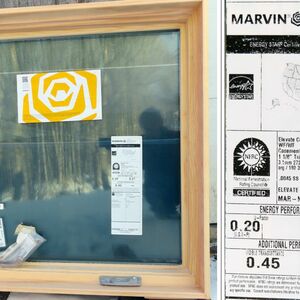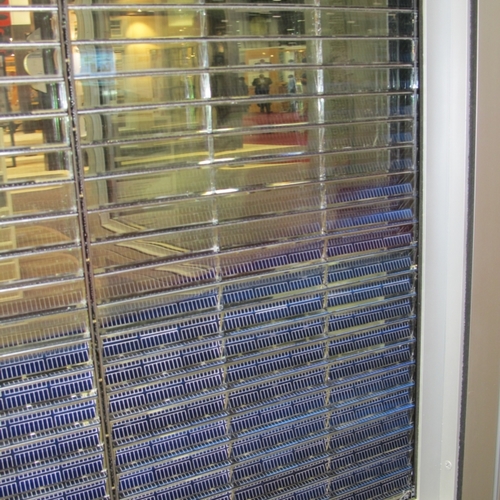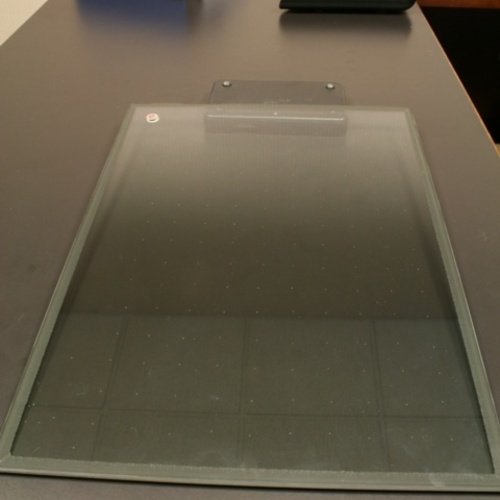
For twenty years or so, companies like Pilkington (Spacia) have been cranking out R-5ish (center-of-glass) vacuum-insulated glazing (VIG). The attraction of glazing units with a very thin profile, relatively low weight, and a high level of performance is strong, particularly for retrofit applications.
But it sure seems as though we have been promised commercially available VIG with double that thermal performance for more than 10 years now. (See Images #1 and #2 in the Gallery, as well as this 2009 blog post by Alex Wilson.) The technological challenges for this level of performance have been significant, and so have costs.
My good friend and colleague, Charlie Curcija — senior researcher in the glazing program at Lawrence Berkeley National Lab — is the guy I always go to for the latest and greatest news on high performance glazing. He says we very well could be there:
“The breakthroughs required for R-10+ VIG were in three areas:
- One, producing uniformly flat tempered glass (this is important for pillars to stay where they are supposed to);
- Two, having temperable low-e (Guardian was one of first companies, if not the first to develop temperable low-e); and
- Three, developing a low-temperature edge sealing process, so that glass does not de-temper.”
According to Curcija, who recently returned from Asia, there are about seven or so Chinese companies that are producing VIG in the R-10+ range (center-of-glass) and just one being produced in the U.S. (by Michigan-based Guardian Glass). Guardian just did a big press event at an AIA conference for their two commercially available VIG products. And then there is Florida-based VIG Technologies, a company that uses LandGlass VIG from China.
So, we’re are all set and just need to talk about pricing, right?
Are the products even available?
Not so fast; both Guardian and VIG Technologies are still very tight-mouthed about the major U.S. window manufacturers they claim to be working with. Apparently, you can’t order product from either of these VIG producers or any window manufacturers to date.
There are real VIG installations in the U.S.: VIG Technologies has units installed at Viracon headquarters in Minnesota (Viracon is the largest glazing manufacturer in the U.S.) and Guardian has some of their units installed as retrofits at Eastern Michigan University (see Images #3 and #4 in the Gallery). By all reports, these units are performing really well. Curcija observed the Viracon units on a cold winter day and said that the units looked great and the thermal comfort near the units was impressive. Robert Densic, Eastern Michigan University’s manager for planning and design, is working on some initial Guardian Glass installations as a proof-of-concept project for much broader applications of VIG products across the campus.
So, what is the hold up?
A lack of industrial capacity
One trusted window industry source told me this: it’s really hard to focus on and marshal resources for new high-performance glazing when the industry is as stoked as it is right now. Charlie Boyer, vice president of research & development for Viracon, backed that up. He said, “We are very interested in this technology but we simply don’t have the capacity right now and are not quite ready to make the very substantial investment required to set up a whole new facility for VIG.”
Additionally, when I asked Guardian Glass some very pointed questions about commercialization, one of their written responses was: “The Guardian Vacuum IG team is focused on multiple industries, with commercial refrigeration leading the way. We have partnered with Anthony International, the leader in the refrigeration door industry.” Huh? Refrigerator doors?
Another trusted industry source told me this: no one in the window/glazing industry has seen any third-party certified laboratory testing of the new VIG product using the industry standard, ASTM E2190, “Standard Specification for Insulating Glass Unit Performance and Evaluation.” This testing includes temperature extremes and accelerated aging/weathering testing. (For more information on this standard, including descriptions of specific tests, see “Certification and Testing for Insulated Class units.”)
A new standard
If you lose the vacuum seal on these IGUs, the thermal performance does not fade — it crashes.
There is a new standard being developed specifically for stress-testing VIG: ISO/DIS 19916-1, “Glass in building—vacuum insulating glass – Part 1: Basic specification of products and evaluation methods for thermal and sound insulating performance.”
Rob Tenent of the National Renewable Energy Lab (NREL) is gearing up for a project looking into the specific stress testing needs of VIG, working with Lawrence Berkeley National Labs (LBNL). Frankly, no one seems to know, or is willing to state, whether these new VIGs require stress testing tuned to their performance or properties. But that is exactly what this NREL/LBNL project is about.
The refrigerator door market
All of this concern could be one of the reasons that Guardian Glass is focusing on the refrigerator door market: While the temperature difference from inside to outside the refrigeration units is large, it represents a fairly steady delta-T.
I am not saying that the VIG seals or long-term performance are suspect; I am saying that no one seems to know or be willing to talk openly on this issue, and it is really important.
How much do these IGUs cost?
What about costs? Not surprisingly, it’s impossible to get this sort of information from VIG Technologies or Guardian Glass at this point. But here is what Curcija learned while in Asia: Chinese VIG producers gave manufacturing costs of up to 1,500 Yuan/m2. Using $1 = 6.7 yuan and roughly 10 sf/m2, that equates to $22 per square foot. In the U.S., it’s typical to multiply manufacturing cost by 3 to get the consumer price (glazing installed in a window), which would mean $66/s.f. for consumer buying windows with VIG. Note that this price does not include any tariffs. For comparison purposes, standard double-glazed IGU in the U.S. is about $10/s.f. retail, with Passive House triple-glazed windows in the range of $30 – $70/s.f.
New VIG from Guardian Glass (made in the U.S.) and VIG Technologies (made in China) are poised to make serious inroads into the high-performance glazing market in the U.S. They are not cheap, but if their long-term thermal performance can be verified, they may very well be worth the cost.
In addition to acting as GBA’s technical director, Peter Yost is the Vice President for Technical Services at BuildingGreen in Brattleboro, Vermont. He has been building, researching, teaching, writing, and consulting on high-performance homes for more than twenty years. An experienced trainer and consultant, he’s been recognized as NAHB Educator of the Year. Do you have a building science puzzle? Contact Pete here. You can also sign up for BuildingGreen’s email newsletter to get a free report on insulation, as well as regular posts from Peter.
Weekly Newsletter
Get building science and energy efficiency advice, plus special offers, in your inbox.















9 Comments
It should be pointed out that there are triple glazed units out there that already have similar CoG u-value (<0.9). That's probably the benchmark they should be compared to. The only real advantage these offer is they are thinner. But if the seal fails, it essentially becomes like a single pane of glass, is what I infer from the article. Seems like there's still a ways to go before these become an attractive option.
Like the other person mentioned. There are already NFRC Certified windows in the USA that have center of glass pushing R-16 and whole window & frame certified R-10. Companies like Alpen and some European companies have these windows ready for residential use. Alpen are double pane glass with a heat mirror center so the window is not that much wider or heavier than a standard dual pane window but it has the efficiency of triple glass glazing. If you desire three actual glass panes, then Euro windows have it, albeit heavier and wider but the performance is there.
Not sure the expense and complications of vacuum insulated glass is in demand right now. It's hard enough to get people to pay a little extra for better windows. People still are resistant to spending more on the building envelope to get better efficiency. People will spend more money on upgraded kitchens, tiles, granite, etc. instead of paying for better windows. That's custom homes, with spec homes, forget about it. Builders always install "builder grade" windows and go code minimum.
The tech sounds interesting but complexity, logistics, long term durability and costs are really a huge mountain to climb. I would like to see one of these windows in real world use for 10+ years without failure before I am confident the technology is sound.
Hi Peter,
Totally off topic but here's a quick tip for you keyboard warriors. To type m², m³ or °F do the following....
For ², hold down the Alt key and then type 0178 on the numeric pad
For ³, hold down the Alt key and then type 0179 on the numeric pad
For °, hold down the Alt key and then type 0176 on the numeric pad
There's lots of others, but you will find these 3 particularly useful
Transparent aluminum is the key to all of this. Where is Scotty when you need him?
Our triple pane Shuco PVC windows are Passive Haus certified and have a COG U-factor of 0.11 (R=9).
We imported them from Germany five years ago.
So why is VIG with R=10 so special?
>So why is VIG with R=10 so special?
1: The potential for a MUCH more favorable price/performance. To hit $22 per square foot for glass of this performance at current very low production volumes already makes it competitive with comparable performance triple pane, and there's almost certainly going to be a financial learning curve if/when volumes ramp up. It's a simpler unit than a triple pane, with the potential to hit price points closer to double panes (since it is just a double low-E double pane, after all.)
2: A favorable thickness (and weight)/performance. It's thinner than a standard double-pane.
I doubt Schuco is making anything in that performance class suitable for a refrigerator door.
We too have been importing low U-value windows for years. We are currently supplying PH windows with Uw=0.68 (certified), and regular windows (non-PH) of Uw=0.74. The standard glazing units we are using are Ug=0.5 (RSI=2), and we can improve on this to 0.4 and in quad glass to 0.3 (RSI=3.33) or R-18. The price difference between double and triple is virtually zero (around 2%), so we don't even offer double. Our windows are $CAD82 ($US63)/sq ft fully finished ready to install. All wood windows, Alu clad exterior, FSC certified. Alec Shalinsky, Vetta Windows, [email protected]
Another product to watch is the "Super Window" being worked on at LBNL. Triple glazed w/ ultra thin center layer of glass with Krypton gas fill and low-e coatings. This is another way to get to R10 with a smaller lighter glass package and avoid the possible life span and quality issues associate with suspended films. I wonder how this will compare in cost per sq ft of glazing to the VIG?
Thomas Nedelsky,
The PR department at LBNL has been using the term "superwindow" for more than a decade. To see a GBA article on LBNL "superwindows" from 2011, see this article: "‘Superwindows’ to the Rescue?"
For a more recent article on the topic, see this 2018 article: "Researchers Develop New ‘Super Window’."
Log in or create an account to post a comment.
Sign up Log in